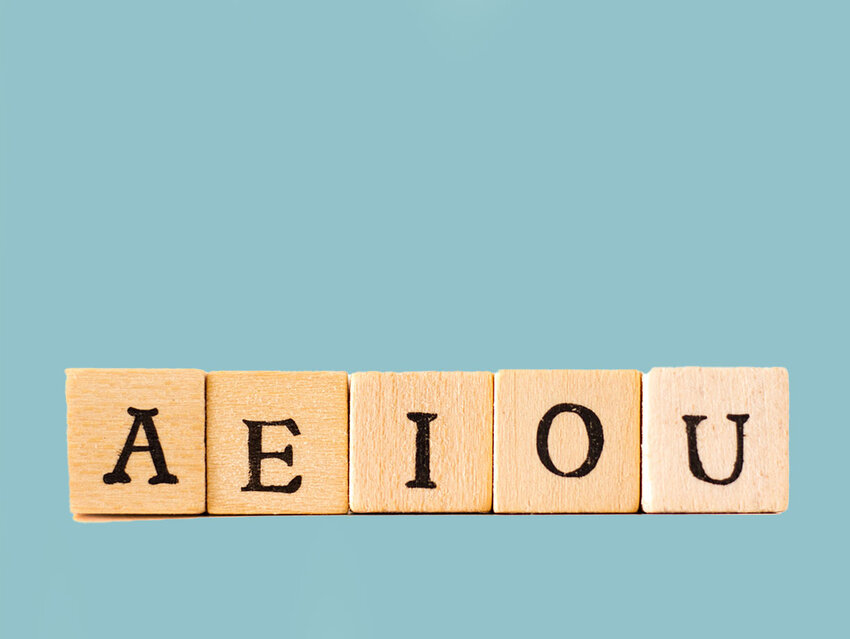We’ve explored the most frequently used “X,” “Y,” and “Z” words in the English language, so let’s take a closer look at the wonderful world of vowels. What follows is a list of the most common words in the English language that start with “A,” “E,” “I,” “O,” and “U.” (We already covered “Y,” so we skipped the “sometimes-Y” exception on this list of vowel words.)
To refresh your memory, the Oxford English Dictionary (OED) delineates frequency of word usage into bands (groups) numbered one through eight, with eight being the highest frequency. You might notice that unlike the “XYZ” list (which contained less-common words in band four, as well as extremely common words in bands seven and eight), this list is dominated by words that fall in bands seven and eight.
And
“And” is first in terms of frequency of usage for words starting with the letter “A,” even before the article “a” itself. It’s a frequency-band-eight word, meaning it occurs more than 1,000 times per million words in typical usage. This grouping includes conjunctions (such as “and”), determiners (“the,” “a,” “this,” “that”), pronouns, and principal prepositions (“of,” “to,” “in”). “And” is used to connect words of the same part of speech, and clauses or sentences that are to be taken jointly. It comes from Germanic roots — even today, the German translation of “and” is und.
About
“About” can be a preposition or an adverb, “used to indicate movement within a particular area,” “to express location at a particular place,” or to articulate the subject one is speaking on. It’s a frequency-band-eight word, and OED marks its earliest usage in the 13th century CE. It traces through the Middle English aboute, from the Old English abutan, meaning “on the outside of; around the circumference of, enveloping; in the vicinity of, near; hither and thither, from place to place.”
Even
OED lists “even” as the most frequently used “E” word. While it can be a verb, it’s primarily used as an adjective (meaning “flat and smooth, or otherwise equal in number, amount, or value”) or as an adverb (to compare, “to emphasize something surprising or extreme,” or “used in questions to indicate confusion or exasperation” — for example, “What are we even doing?”). It comes from the Germanic ebna-, meaning “level, plain, smooth.” It’s a frequency-band-seven word, meaning it occurs between 100 and 1,000 times per million words in typical modern English. This band includes the semantic words that form the basis of everyday language — nouns including the basic terms for people (“man,” “woman,” “person”), body parts (“hand,” “foot,” “blood”), and measurements of time (“year,” “day,” “hour”).
Each
“Each” is listed as the OED’s second most frequently used “E” word, after “even.” It can be a determiner, “used to refer to every one of two or more people or things, regarded and identified separately.” It can be a pronoun, standing in for each of these separately identified people or things. Or it can be an adverb, meaning “to, for, or by every one of a group” (when used after a noun or an amount — for example, “they cost $11 each”). “Each” has Germanic roots and falls within frequency band seven.
Important
While the top “I” words contained the usual suspects — the pronoun “I,” and the words “in” and “it” — we grabbed a few from further down the list to keep things “interesting” (No. 11 on the frequency list). “Important” is an adjective describing something “of great significance or value; likely to have a profound effect on success, survival, or well-being.” It appeared in English in the mid-15th century from the Medieval Latin importantem, meaning “momentous.” It’s a frequency-band-seven word.
Include
“Include” is also a frequency-band-seven word; it’s a verb that means “to comprise or contain as part of a whole,” or “to make part of a whole or set.” It came to English in the early 15th century by way of the Latin includere, meaning “to shut in, enclose, imprison, insert.”
Own
Beneath the core English words “of,” “on,” and “or,” you’ll find “own” on the list of the most frequently used “O” words in the OED. This frequency-band-seven word can be an adjective (“used with a possessive to emphasize that someone or something belongs or relates to the person or thing mentioned”), a pronoun (“something that belongs to the person or thing mentioned”), or a verb (meaning “to possess”). We get this word from the Middle English ouen, which in turn came from the Proto-Germanic aiganaz (“possessed, owned”).
Order
“Order” is another frequency-band-seven word, used as a noun or verb. In an overarching sense, it refers to “the arrangement or disposition of people or things in relation to each other according to a particular sequence, pattern, or method.” This can be applied innumerable ways — a command structure within a particular social, political, or economic system, for example, or simply the quality, nature, or importance of something. It originated in English around 1200, meaning “body of persons living under a religious discipline,” from the Old French ordre (“position, estate; rule, regulation; religious order”), but it began to take on more secular connotations in 1300.
Use
“Use” appears to be the most frequently used “U” word in the OED, particularly when employed as a verb — it’s slightly less frequent as a noun. This frequency-band-eight word means “to take, hold, or deploy (something) as a means of accomplishing a purpose or achieving a result.” It came to English from the Old French user (“employ, make use of, practice, frequent”) around 1200.
Understand
“Understand” is a frequency-band-seven word — the transitive verb means “to perceive the intended meaning of (words, a language, or a speaker).” It comes from the Old English understandan, meaning “to comprehend, grasp the idea of, receive from a word or words or from a sign the idea it is intended to convey.”
Featured image credit: JannHuizenga/ iStock

